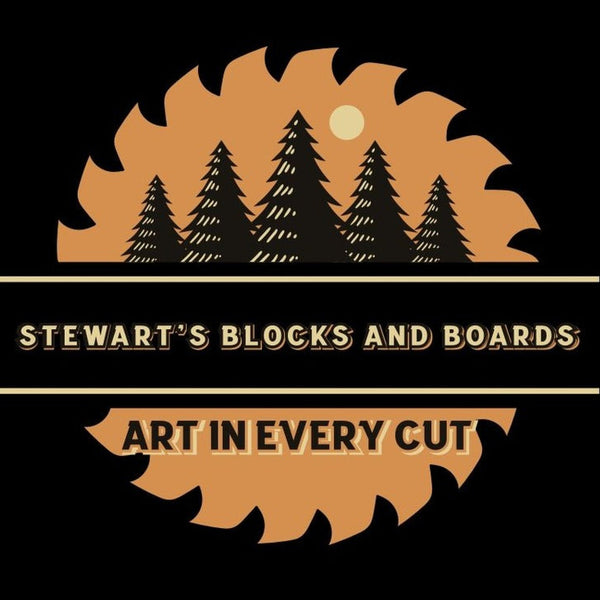
Handcrafted Butcher Blocks: DIY Beginner's Guide
Share
Welcome to the world of handcrafted cutting boards and butcher blocks, where utility and artistry blend seamlessly to create stunning kitchen essentials. Whether you're an experienced woodworker or just starting out, learning how to craft your own butcher blocks can be a rewarding adventure. This guide is perfect for beginners who wish to dive into the craft of making beautiful, functional pieces. Let's get started!
Why Choose Handcrafted Butcher Blocks?
Handcrafted butcher blocks offer more than just a functional workspace in the kitchen; they bring warmth, character, and a touch of personal craftsmanship into your home. Unlike mass-produced alternatives, each handmade piece is unique, showcasing the artisan's skill and choice of materials.
There's something inherently satisfying about creating something beautiful with your own hands. Plus, when you craft your own butcher blocks, you have full control over the design, size, and materials, ensuring that your board complements your kitchen perfectly.
Getting Started: Essential Tools and Materials
Creating handcrafted butcher blocks does require some basic woodworking tools and materials. Here are a few essentials you'll need before you start:
Tools
- Circular Saw or Table Saw – For cutting your wood to size.
- Planer – To smooth the surfaces of your wood pieces.
- Router with a Round-Over Bit – For adding professional-looking edges.
- Clamps – Vital for holding your pieces together securely during glue-ups.
- Sander or Sandpaper – For smoothing surfaces and rounding edges.
- Dust Mask – Essential for safety when sanding.
Materials
- Wood – Choose hardwoods for durability and aesthetics, like maple, walnut, or cherry.
- Wood Glue – Ensure it's food-safe and strong.
- Food-Safe Finish – Such as mineral oil or beeswax, to protect and finish your butcher block.
Choosing the Right Wood
Selecting the right type of wood is crucial for a successful project. Hardwoods are preferred for making cutting boards and butcher blocks as they're dense and can withstand heavy use. Here are a few popular choices:
- Maple: Known for its durability and tight grain.
- Walnut: Offers a rich, dark appearance.
- Cherry: Offers a smooth grain and rich color that deepens over time.
Unique Wood Combinations
If you're inspired by creative wood combinations, consider exploring some exotic options. For instance, our online store features a Wenge, Padauk & Tigerwood Cheese Slicer that showcases striking color contrasts, perfect for a unique, handcrafted aesthetic.
Constructing Your Butcher Block
The process of building your butcher block involves several key steps: preparing the wood, gluing the pieces together, shaping the block, and finally, finishing it.
Step 1: Prepare the Wood
Start by slicing your chosen wood into strips using a table saw. Aim for even, straight cuts, as this will make the gluing process easier. Once you've cut your strips, use a planer to ensure they're perfectly flat on all sides.
Step 2: Glue the Strips Together
Arrange your wood strips in the pattern you desire, making sure they're tightly aligned. Apply a thin, even coat of wood glue to each side that will be joined, then clamp the assembled pieces together. Allow the glue to dry overnight.
Step 3: Shape the Block
Once the glue has thoroughly dried, use a saw to trim the ends and edges to your desired size. Round the edges using a router with a round-over bit for a smooth, finished look.
Step 4: Sand and Finish
With the block shaped, begin sanding with coarse-grit sandpaper, gradually moving to finer grits until the surface is smooth to the touch. Finally, apply a food-safe finish to enhance the wood's natural beauty and protect the surface.
Consider adding a distinctive touch with a Mini Black Walnut Cutting Board with Handle, offering convenience and aesthetics perfect for serving.
Maintaining Your Butcher Block
Maintaining the beauty and functionality of your handcrafted butcher block is relatively straightforward:
- Clean Regularly: Use a damp cloth to wipe down after use; avoid soaking in water.
- Oil Often: Regularly apply a food-safe mineral oil or a beeswax finish to keep the wood hydrated and prevent cracking.
- Avoid Extreme Conditions: Keep out of direct sunlight and away from direct heat sources.
Expanding Your Woodworking Skills
Once you've mastered the basics of constructing a butcher block, you might want to expand your woodworking repertoire. Consider creating a Handcrafted Lazy Susan, a perfect centerpiece for your dining table.
Handcrafting butcher blocks is just the beginning; with practice, you'll be able to make various other kitchen essentials and decorative pieces. Check out more handcrafted designs on our website.
Conclusion: Embrace the Craft
Creating handcrafted butcher blocks not only equips your kitchen with functional art but also brings a sense of personal accomplishment. Each board you craft tells a story of patience, skill, and unique aesthetic vision. So why wait? Grab your tools and start crafting your very own handmade masterpiece today!
For more inspiration and to explore a range of beautifully handcrafted cutting boards, cheese slicers, and more, visit Stewart's Blocks and Boards.



